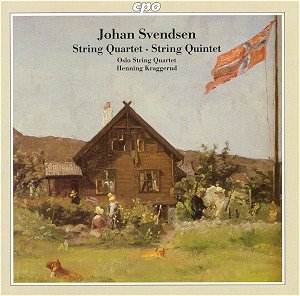The Norwegian composer Johan Svendsen was disloyal
to his wife and paid a hefty price. Svendsen was sent a bouquet
of flowers and a love note from one of his female friends. Unfortunately
for Svendsen, the flowers and note went winging their way to his
wife. Now comes the musical part of the story. Svendsen, already
having two symphonies under his belt, had just completed his third.
Iím sure he wishes he had locked it away, but the sad fact is
that he left in his desk drawer. Svendsenís wife collected all
the pages and threw them in the red-hot fireplace. So long, Symphony
No. 3!!
You might find this hard to believe, but Svendsen
never really recovered from the burning incident. He cut down
greatly on the time he spent on composing in the years ahead and
never did come up with his 3rd Symphony, concentrating
instead on his love of conducting. At any rate, Svendsen eventually
became highly prized for his conducting skills and was even offered
the positions of Chief Conductor of the New York Philharmonic
Orchestra and the Metropolitan Opera. Svendsen declined the job
offers, a decision that certainly contributed to his relatively
obscure current reputation.
Did Svendsenís traumatic event deprive us of
one of the greatest composers ever to walk the Earth? His fellow
Nowegian composer Edvard Grieg might cast a positive vote in that
he withdrew his own Symphony upon hearing Svendenís Symphony No.
1 in D major. Of course, at least part of Griegís decision was
based on his lack of confidence at the time in writing a large-scale
work.
We can only speculate as to how Svendsen might
have progressed as a composer if he had not turned to a full life
of conducting. Still, the works he did create reveal a composer
having expert structural abilities and a fine penchant for melodic
development.
Svendsen composed his String Quartet in A minor
in 1865 while he was on a scholarship in Leipzig; the work was
premiered at the graduation concert in May of that year and was
well received. Svendsenís String Quintet in C major also premiered
at a graduation concert in 1868 when he was coming to the end
of his Leipzig studies. Both works offer highly pleasant music
of an upbeat nature, never veering toward the emotional depths
of a typical Brahms chamber work.
One of the prime traits of these two chamber
works is that Svendsenís lyricism sounds so natural and comfortable.
The result is an entirely uplifting musical experience sure to
boost oneís frame of mind. He also has a knack for delicious turning
of phrases and attractive foot-tapping rhythms. I donít want to
give the impression that Svendsen only delivers the softer side
of life. There is effective tension and urgency in each movement,
but Svendsenís tendency is always to get back to his comforting
home base.
Most impressive is the Theme with Variations
Movement of the String Quintet, as it is a compendium of the breadth
of Svendsenís artistry. Consisting of a basic theme with six variations
and a coda, each variation is unique and memorable. In this Movement,
Svendsen assuredly displays all his compositional gifts including
the essential elements of contrast. The 3rd Variation
is a hushed and fragile gem with absolutely gorgeous melodies
and phrasing; itís worth the price of the disc by itself.
The Olso String Quartet was formed in 1991 and
has many recordings for Naxos and other record labels to its credit,
including the complete Nielsen String Quartets. This splendid
ensemble group has garnered much praise and plans future recordings
of the music of Hugo Wolf, Jean Sibelius, and Alban Berg.
I first became familiar with the Oslo String
Quartet when I was working on a review project of the recordings
of Nielsenís Four String Quartets. As it happens, The Kontra Quartet
also had a set on the market from BIS. To make a long story short,
I considered the Oslo groupís set one of the best on disc and
the Kontra at the bottom of the pile. There were two major problems
with the Kontra set: over-romanticized and cultured playing and
a cavernous sound stage that gave the impression that at least
eight instruments were on display. In contrast, the Oslo String
Quartet was working from a natural acoustic, and it fully realized
the late-romantic nature and rustic appeal of Nielsenís music.
Nothing but time has changed since those Nielsen
reviews of a few years ago. The Kontra Quartet still occupies
a slick and ĎCarlsbad Cavernsí soundstage and plays with its customary
romantic inclinations, while the Oslo String Quartet continues
to perform idiomatically and incisively. To the best of my knowledge,
only the Kontra and Oslo Quartets have available recordings of
the String Quartet, and the Oslo has the field to itself in the
String Quintet. I trust that Svendsen would agree that this ensemble
group is an excellent champion of his chamber music.
In conclusion, these two Svendsen string chamber
works are wonderful works that I recommend strongly. Also strongly
recommended are the performances by the excellent Oslo String
Quartet. If youíre open to the byways represented by the Scandinavian
portrayal of the Romantic era, do treat yourself to this throroughly
enjoyable recording.
Don Satz
